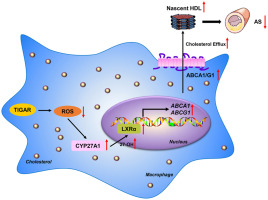Background and aims
TP53-induced glycolysis and apoptosis regulator (TIGAR) is now characterized as a fructose-2,6-bisphosphatase to reduce glycolysis and protect against oxidative stress. Recent studies have demonstrated that TIGAR is associated with cardiovascular disease. However, little is known about its role in atherosclerogenesis. In this study, we aimed to investigate the effect of TIGAR on atherosclerosis and explore the underlying molecular mechanism.
Methods
The Gene Expression Omnibus (GEO) datasets were used to analyze the differential expression of relative proteins. THP-1-derived macrophages were used as an in vitro model and apolipoprotein E-deficient (Apoe-/-) mice were used as an in vivomodel. [3H] labeled cholesterol was used to assess the capacity of cholesterol efflux and reverse cholesterol transport (RCT). Both qPCR and Western blot were used to evaluate the mRNA and protein expression, respectively. Lentiviral vectors were used to disturb the expression of TIGAR in vitro and in vivo. Oil Red O, hematoxylin-eosin, and Masson staining were performed to evaluate atherosclerotic plaques in Apoe-/- mice fed a Western diet. Conventional assay kits were used to measure the levels of reactive oxygen species (ROS), plasma lipid profiles and 27-hydroxycholesterol (27-HC).
Results
Our results showed that TIGAR is increased upon the formation of macrophage foam cells and atherosclerosis. TIGARknockdown markedly promoted lipid accumulation in macrophages. Silencing of TIGAR impaired cholesterol efflux and down-regulated the expression of ATP-binding cassette transporter A1 (ABCA1) and ABCG1 by interfering with liver X receptor α (LXRα) expression and activity, but did not influence cholesterol uptake by macrophages. Additionally, this inhibitory effect of TIGAR deficiency on cholesterol metabolism was mediated through the ROS/CYP27A1 pathway. In vivoexperiments revealed that TIGAR deficiency decreased the levels of ABCA1 and ABCG1 in plaques and aorta and impaired the capacity of RCT, thereby leading to the progression of atherosclerosis in Apoe-/- mice.
Conclusions
TIGAR mitigates the development of atherosclerosis by up-regulating ABCA1 and ABCG1 expression via the ROS/CYP27A1/LXRα pathway.
